-
Posts
1,148 -
Joined
-
Last visited
-
Days Won
5
Content Type
Profiles
Forums
Gallery
Events
Blogs
BMT Wiki
Collections
Store
Posts posted by 67RModel
-
-
On 1/16/2023 at 10:22 PM, mowerman said:
Just going to get worse work force just keeps getting worse stay up all night tire chains forget it the industry needs to come up with something else … Bob
Go back to industry regulation? I mean isn't it universally understood that the Motor Carrier Act of 1980 (deregulation) was the beginning of the end for the trucking industry? 30+ years of cutthroat competition and a drag race to the bottom have pretty much created what we have now. There is literally zero barriers for entry. You can get operational authority in less than 2 hours, and anyone with a computer and internet connection can become a broker. Deregulation is what basically created "big box" stores too. From what I hear from every single person who was involved in trucking prior to deregulation was that it was better staffed, better managed, and you could make fistfuls of money as a driver and/or owner (relative to the times). On the other hand heavy government price and entry controls to an industry is pretty un-American. In the end The American consumer won and Truckers Lost.....big time.
-
 2
2
-
-
Possibly frame crossmember(s) and/or tranny mounts too. I would think the best route to go would be to find an R6XX of the same model year as yours that is factory 8LL and use the VIN number from it. There will be other small details too like the clutch linkage and the cab floor access panel / shift lever boot. Possibly your puff limiter system if you have one is tied into your current Mack tranny. I don't think the Eaton equipped trucks came with the torque limiting valves....not really a big deal though. I have seen this same type of thread many times on here about swapping out a Mack tranny for an Eaton and they seem to never get resolution. It usually just starts out as someone asking what's involved but then we never hear if they ended up doing it and/or what the details involved were. I don't know if its because the guys end up realizing its too much work or if the cost/benefit just isn't there. Let us know what you find out.
-
I imagine if you click on any of these links you will be paid to take a flight.
-
 2
2
-
-
No affiliation. Saw it on Craigslist and thought I would share it here for other Mack enthusiasts to see. Certainly a rare find for sure. Should be put into someone's collection.
https://swv.craigslist.org/hvo/d/bluefield-mack-23k-original-miles1984/7578058365.html
-
 1
1
-
-
5 hours ago, A Smith said:
Does it mean my engine block is cracked
Sure sounds like it. There are others on here who will be along shortly that may know of a simple test you could do to find out. If the oil cooler broke and small holes appeared near the freeze plugs there is likely damage other places too.
-
7 hours ago, mowerman said:
I even bought her the entire series in DVDs my god how much of this worn out shit can you handle I would rather be watching commercials… Bob
Can't you just use this as an excuse to go out and work on the DM? I mean any time it comes on the TV just make yourself scarce and disappear out to the garage...Everybody is winning at that point.
-
Also, for some reason I want to think you are from Florida if I remember correctly. There is a large Mack junkyard in Sparr, FL called Sparr Truck Parts. They have/had a thread on here in the parts for sale a long time ago and got resurrected a few times. You can look them up on Google. Not sure how far away from Sparr you are but maybe check with them. I think its just North of Ocala.
-
I have the vin number for a couple late 80s R models you can use to get the parts you need from Mack.....as a last resort. I'm sure you are not yet ready to surrender all 4 of your limbs and first born child for a few parts from Mack of Sweden haha.
-
The one I have for sale is a 1972. Its technically still an ENDT675 2 valve maxidyne engine. The E6 nomenclature came around in the very early 1980s. Not sure how much difference there would be between the two versions...probably not much for the external pieces you need. At any rate I'm not ready to part this one out anyway. Still trying to get it gone as a complete unit.
-
Series 60 was the engine that saved Detroit Diesel along with Roger Penske's money and John Deere Corporation. Not too many people know but in the in the mid 1980s John Deere and Detroit Diesel formed a joint venture to co-develop engines for on highway applications and off road machinery. Detroit's 2 cycle was all but dead and Deere was in a bad financial position from horrible farm economies of the late 70s and early 80s. Deere engineers had the knowledge to design and build reliable 4 stroke diesels. The joint venture was named Detroit Deere Corporation (DEDEC). Roger Penske swooped in at the last minute and bought Detroit Diesel and poured mountains of money into the prototype engine called the Tech 80, which would become the Series 60. John Deere's 12.5 liter Powertech engines have often been called Series 60 clones since they were introduced a few years after the 60 Series debuted. Attached are two pictures of corporate literature of the merger company that really never came to fruition. How much engineering and information exchange that took place between Detroit and Deere leading up to Penske buying Detroit and nixing the corporate merger deal is unknown. However, based on how similar the Series 60 and Deere 12.5 liter Powertechs are......a lot?
-
 2
2
-
-
Engineering knowledge from John Deere is what saved Detroit Diesel along with Roger Penske's money. I just made a post about this a few days ago in another unrelated thread. Ill copy and paste it here.
-
 1
1
-
-
What year engine and engine size are we talking here. Get the information from the tags and stickers on the sides of valve cover. Also the make and year of the truck could help if you know for certain the engine is original to the truck. It literally says there is some type of EGR fault on your scanner so there is a good chance its not a 12.7? The information seems contradictory but I'm no DD guru.
-
I am way off topic on this thread but if we are reminiscing about the Series 60......
-
Series 60 was the engine that saved Detroit Diesel along with Roger Penske's money and John Deere Corporation. Not too many people know but in the in the mid 1980s John Deere and Detroit Diesel formed a joint venture to co-develop engines for on highway applications and off road machinery. Detroit's 2 cycle was all but dead and Deere was in a bad financial position from horrible farm economies of the late 70s and early 80s. Deere engineers had the knowledge to design and build reliable 4 stroke diesels. The joint venture was named Detroit Deere Corporation (DEDEC). Roger Penske swooped in at the last minute and bought Detroit Diesel and poured mountains of money into the prototype engine called the Tech 80, which would become the Series 60. John Deere's 12.5 liter Powertech engines have often been called Series 60 clones since they were introduced a few years after the 60 Series debuted. Attached are two pictures of corporate literature of the merger company that really never came to fruition. How much engineering and information exchange that took place between Detroit and Deere leading up to Penske buying Detroit and nixing the corporate merger deal is unknown. However, based on how similar the Series 60 and Deere 12.5 liter Powertechs are......a lot?
-
 1
1
-
 1
1
-
-
8 hours ago, Dimplezz said:
Hopefully this is it.
Your joking right?
-
 1
1
-
-
9 hours ago, DM800guy said:
Morning,
Did you happen to check which size rims there on. For my rig I need 8.0’s the rubber would still work. But I would like to know what you have there.
See the attached pictures they are 8.5” to the inside edge of the profile where the wedge anchor seats. 10” overall width.
-
- Popular Post
My head is spinning from all the issues and concerns that are flashing through my head. Yes the E6 will fit in the space and probably mount up without too much trouble. After that it will be an enormous struggle getting all the odds and ends and details sorted out. If the truck had an electronic E7 then the it was some version of Vmac. All the gauges, indicator lights and alarms are wired through and integrated into the Vmac module. I have studied the wiring schematics for the two versions. Even fully mechanical E7 and Vmac 1 are very different electronically. Not only will you have issues under the hood getting things to work. The cab integration will be a nightmare too. Plus you say you are new to working on big trucks. No disrespect but I would renege on this one while its still early.
-
 4
4
-
I have always wanted to try rhubarb pie but nobody I know makes it and you definitely can’t get it at any stores or bakery’s…at least none I know of. And yes I have always wanted to try plum pudding and also fig pudding like they say in the one Christmas song. Like where do you even get fig pudding?
-
The CL uses the cab from the CH. Very different than an R model cab. The R model cab is much smaller inside and a very different dash and gauge layout. The CL713 has a much beefier frame and chassis. The frame rails are much deeper than on a 600 series R model chassis. There is probably other things but those are probably the two biggest….cab and chassis.
-
2 hours ago, Joey Mack said:
I am cautious, and I doubt someone with a clip board is going to inspect my set-up in the middle of a storm.
Yea I agree.
-
I hate to resurrect this oldish thread again. I spent entirely too much time this week on BMT and here its midnight on Saturday and I'm still on it lol. Anyway, I spent a lot of time reading old threads and looking back through the photo albums. What I realized is this place used to be super rowdy and aggressive. I mean there are a lot of threads that are down right nasty and hateful. This was in the 2017 - 2019 timeframe. I have never experienced anything like those threads in my time here. I came in about when all that seemed to be ending in early 2020. I was thinking maybe that hostility drove a lot of guys away. Or if they were not directly involved in the conversations just said screw it and decided to log on anymore and read a bunch of negativity.
-
 1
1
-
-
He last logged on December 30, 2022...so like a week ago.
-
OK I got this figured out now thanks to the video @Onyx610 posted and actually having time to sit down and watch it. The video along with some other sources got me all straightened out. Mechanically governed E7s use the LDA system and not the puff limiter system. For those that don't know and want to know here goes: In a cold start scenario the puff limiter system (think E6 and possibly older) is full rack by default. Rack travel becomes limited once you release the spring brakes and air is sent to the injector pump. Once boost pressure is sufficient for full rack the boost pressure overcomes the air pressure supplied by the parking brake valve via the reversing valve that is tapped directly into the intake manifold. Boost pressure and chassis air pressure are always hydraulically "battling" each other in the reversing valve for control of the air cylinder in the injection pump. In a cold start scenario the LDA system is limited rack by default. There is no reversing valve at the intake like the puff limiter system. The LDA system just has a line tapped into the intake and constantly adjusts rack travel based on boost pressure alone. No compressed air is involved. In a cold start scenario limited rack is not desirable so a workaround is needed. That is the purpose of the valve in the first picture a few posts back. It is a Bendix SV-1 Syncro Valve. When you flip the dash switch to "on" for the CAC bypass, tank air (assuming it hasn't all leaked out) is sent to the SV-1 valve as well as to the two cylinders in the bypass duct plumbing. The cylinders simultaneously close the CAC outlet and open the bypass duct allowing warm compressed air to directly enter the intake manifold. The air sent to the SV-1 valve is regulated down to whatever maximum boost pressure is and passed down and connected to the the tee fitting in the intake manifold where the LDA is tapped into. Thus, the LDA is "fooled" into thinking boost is max and full rack is available before you start cranking the starter. Once the truck warms up a little the CAC bypass can be switched off, the air cylinders cycle back to their normal positions, boost air begins passing through the CAC normally, the air going to the SV-1 valve is exhausted, and the LDA goes back to sensing whatever the actual manifold pressure is. Of course it doesn't stop there. Both systems utilize a torque limiting valve if the truck has a Mack transmission. Once running, if the transmission is put into reverse and/or the low forward gear(s) the torque limiting valve is activated. It is piped from its location on the transmission up to the reversing valve (puff limiter) or to the tee where the LDA is tapped into the manifold. Once its activated it dumps the boost pressure to atmosphere that would normally build up in the system and allow full rack travel. By doing this rack travel is limited in both systems to protect the drivetrain in the low and reverse gears. Once the shift rails are moved to select a higher gear the torque limiting valve closes and allows boost pressure to build up and allow for full rack travel in the injection pump. Below is a picture taken out of my E7 book explaining that all fully mechanical E7s made after 1991 have the CAC bypass setup installed by default. I assume the VMAC trucks can electrically advance the timing during cold startup making this system not necessary for them. I will say that I have consistently been able to start my truck down into the low 30s high 20s temperature range without using this system and it fires up very quickly.
-
 1
1
-
-
Also, I think it technically illegal by National Electric Code to use a standby generator without a transfer switch. Automatic or manual.
-
 2
2
-


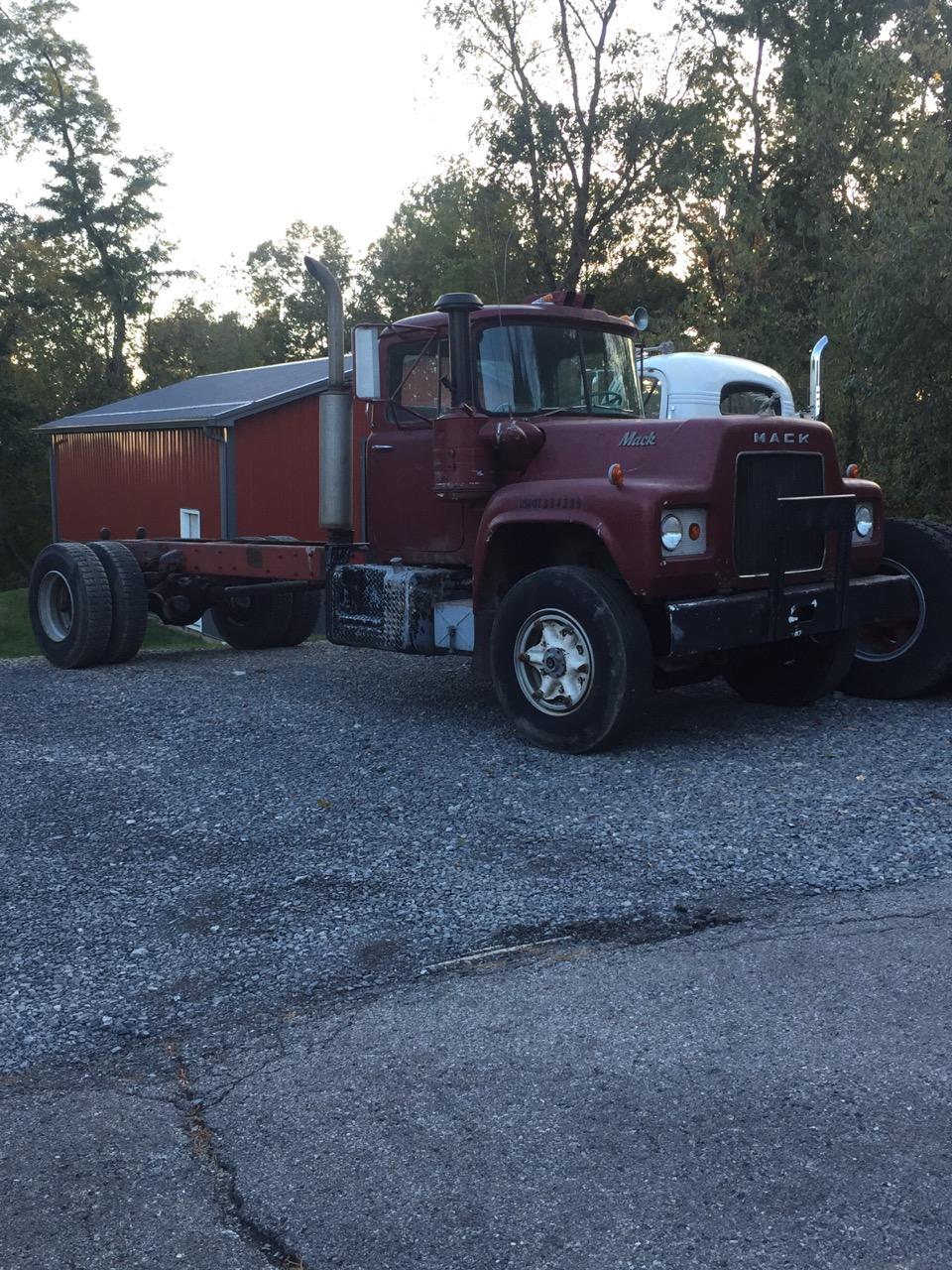

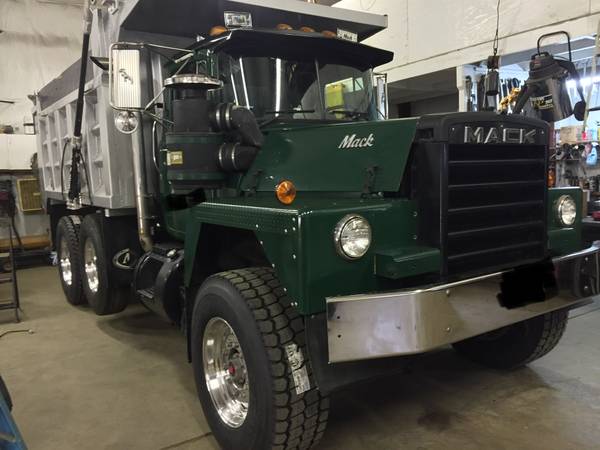

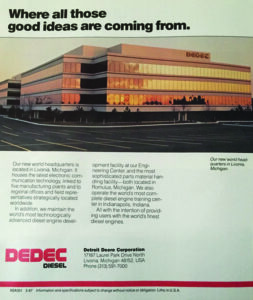

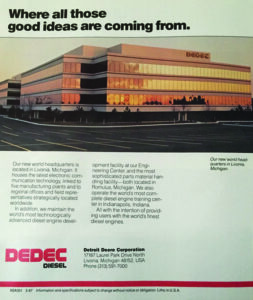
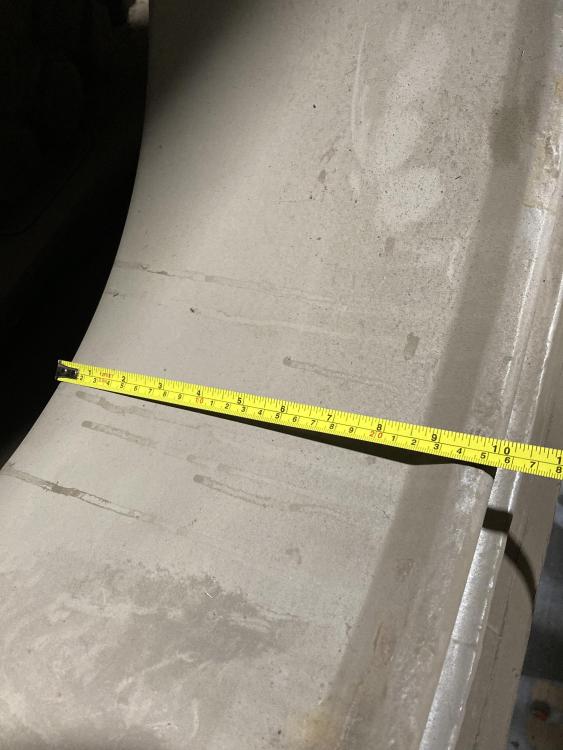
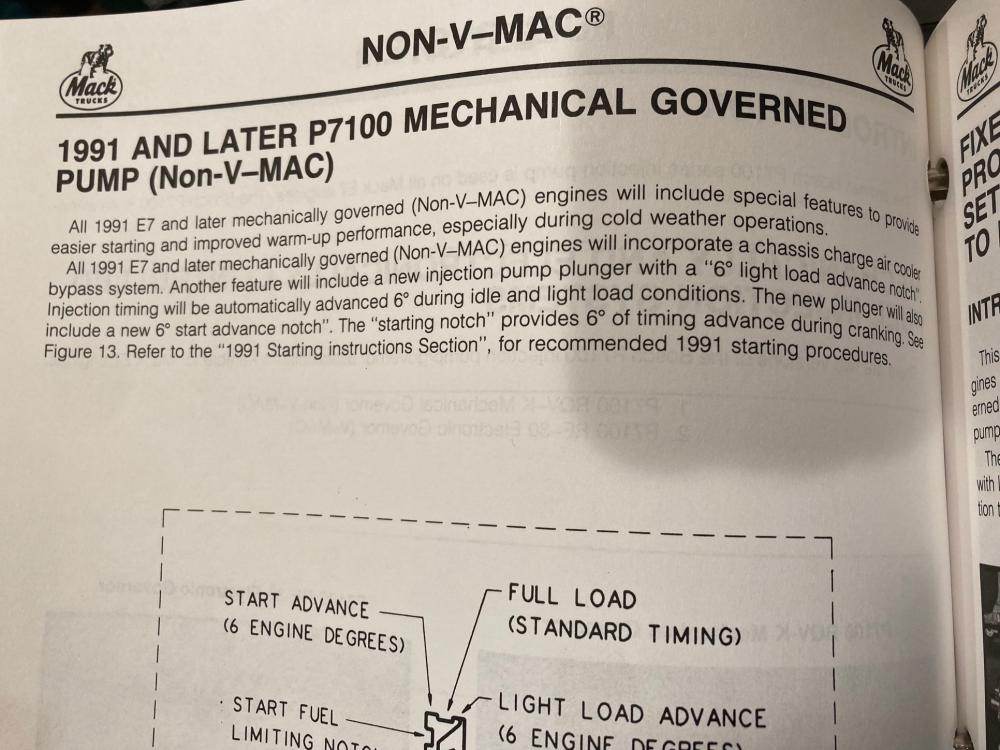
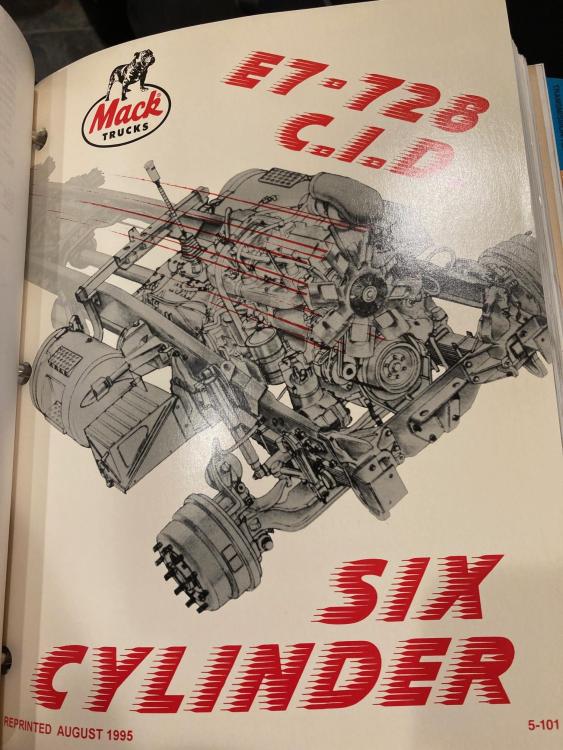
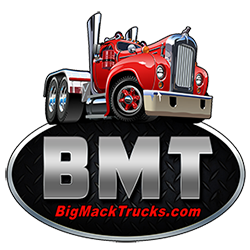
Newbie with 1980 Mack R model dump truck
in Antique and Classic Mack Trucks General Discussion
Posted
Its on the passenger side outside surface of the frame rail behind the wheel/tire. A wire brush or wire wheel on a cordless drill really helps to make it legible one you locate it.